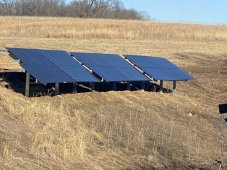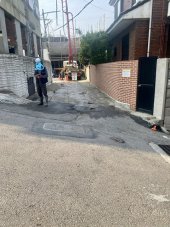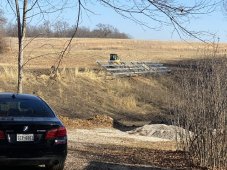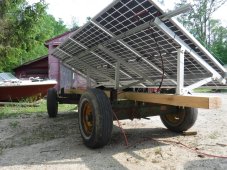hwy17
Anti-Solar Enthusiast
I'm installing an EG4 Brightmount on concrete footers. The installation guide recommends 3' by 20" wide concrete footers. These mounts are 4 panels / 4 footers so 1:1 footer to panel.
I'm not going to be installing to that spec because I don't want to buy all that concrete and I think I can get away with less. Peak gust wind speed I have observed in 3 years of monitoring here is 35mph. These will be in an open field surrounded by fences so I can't imagine the array blowing into a house or something.
I am really inclined to go with 2 foot depth because then I can buy 4ft form tubes and cut them in half, but if I decide I have to do 3ft I will.
I'm thinking along the lines of:
8" x 2ft protruding 8" from the ground, 2x60lb bags concrete
10" x 2ft protruding 8", 3 bags
8" x 3ft protruding 12", 3 bags
10" x 3ft protruding 16", 4 bags
And would you add reinforcement? I thought of using threaded rods that go all the way down, but that's pricey. Probably easier to add 4x rebar and jiggle them in to get bubbles out as well. Then 4 galvanized bolts set into the top to mount the brightmount base to.
I'm not going to be installing to that spec because I don't want to buy all that concrete and I think I can get away with less. Peak gust wind speed I have observed in 3 years of monitoring here is 35mph. These will be in an open field surrounded by fences so I can't imagine the array blowing into a house or something.
I am really inclined to go with 2 foot depth because then I can buy 4ft form tubes and cut them in half, but if I decide I have to do 3ft I will.
I'm thinking along the lines of:
8" x 2ft protruding 8" from the ground, 2x60lb bags concrete
10" x 2ft protruding 8", 3 bags
8" x 3ft protruding 12", 3 bags
10" x 3ft protruding 16", 4 bags
And would you add reinforcement? I thought of using threaded rods that go all the way down, but that's pricey. Probably easier to add 4x rebar and jiggle them in to get bubbles out as well. Then 4 galvanized bolts set into the top to mount the brightmount base to.







